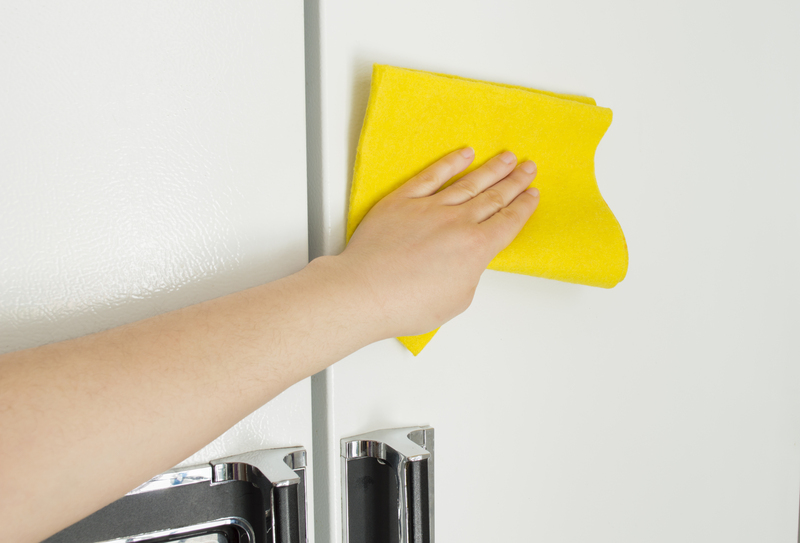Step-by-Step Guide to Perfect Jewelry Cleaning
Posted on 27/09/2025
Step-by-Step Guide to Perfect Jewelry Cleaning
Jewelry cleaning is essential not only for maintaining the brilliance and beauty of your cherished pieces, but also for preserving their value over time. Whether you own delicate gold chains, sparkling diamond rings, intricate silver brooches, or costume pieces, ensuring that each piece stays free of grime and tarnish will help them look their best for years to come. This comprehensive guide presents a step-by-step process for effective jewelry cleaning, tailored to different materials and types. Follow each method below for sparkling, radiant jewelry every day!
Why Is Regular Jewelry Cleaning Important?
Proper jewelry cleaning enhances more than just the luster of your pieces--it also helps prevent long-term damage. Oils from the skin, dust, sweat, lotions, and other environmental elements can dull stones, wear down plating, and weaken clasps. Regular cleaning is an integral part of jewelry care and can even highlight issues such as loose stones or bent prongs before they become major problems.
Key Benefits of Cleaning Your Jewelry
- Restores brilliance: Removes dirt and oil buildup for maximum sparkle.
- Prevents tarnish: Especially vital for silver and plated pieces.
- Protects against damage: Keeps prongs, clasps, and settings in good shape.
- Hygienic: Reduces bacteria and allergens.
- Prolongs lifespan: Well-cared-for jewelry stands the test of time.

Gather Everything You Need for Jewelry Cleaning
Before you begin, assemble your jewelry cleaning kit. The process is simple, and you likely have most supplies at home. For DIY jewelry cleaning, gather the following:
- Mild dish soap
- Warm water
- A soft-bristled toothbrush or dedicated jewelry brush
- A soft, lint-free cloth or microfiber towel
- Bowl (preferably glass or plastic, avoid metal bowls with certain jewelry)
- Optional: ammonia or baking soda (for stubborn grime)
- Optional: a jewelry polishing cloth
Step-by-Step Jewelry Cleaning Guide
Step 1: Inspect Your Jewelry Carefully
Always examine your jewelry before cleaning. Look for loose stones, bent prongs, worn clasps, or cracks. If you notice significant damage, consult a jeweler to avoid causing further harm during the cleaning process.
Step 2: Prepare the Cleaning Solution
In a bowl, mix a few drops of mild dish soap with warm (not hot) water. The water should be safe to touch, as extremes in temperature can damage certain stones and metals. Avoid harsh chemicals--gentle soap is ideal for regular jewelry cleaning.
Step 3: Soak Your Jewelry
- Place your jewelry in the solution for 10-15 minutes. This helps loosen dirt, grime, and lotions.
- Do not soak porous stones--such as pearls, opals, or turquoise. For these, proceed immediately to the next step.
Step 4: Gently Brush Your Jewelry
Use a soft toothbrush to gently scrub your jewelry. Pay special attention to prongs, settings, and seams where dirt may hide. Brush in gentle, circular motions to avoid scratching the metal or gemstones. For intricate pieces, use a brush with extra-fine bristles.
Step 5: Rinse Thoroughly in Clean Water
Hold your jewelry under running lukewarm water to remove any leftover soap and loosened debris. You can use a separate bowl of clean water if you're concerned about stones falling out or items slipping down the drain. Repeat rinsing if necessary.
Step 6: Dry and Polish
- Pat jewelry gently with a lint-free cloth. Avoid paper towels or rough fabrics that could scratch.
- Let jewelry air-dry completely before storing.
- Use a jewelry polishing cloth for an extra shine on metal surfaces.
Special Care for Different Types of Jewelry
Cleaning Gold Jewelry
Gold jewelry (both yellow and white gold) is resilient but can still be scratched or dulled by harsh chemicals. Always use mild soap and a very soft brush. For persistent smudges, add a drop of ammonia to your cleaning solution for extra power--but never use ammonia on pieces with pearls or gemstones!
Cleaning Silver Jewelry
Silver tarnishes quickly due to its reaction with sulfur in the air. A polishing cloth is often the simplest route, but for deep cleans, soak silver jewelry in a solution of mild soap and water, then brush gently. If totally tarnished, create a paste of baking soda and water and rub lightly with a soft cloth. Rinse thoroughly and buff to a shine.
Cleaning Gemstone Jewelry
Each gemstone has unique requirements. Diamond jewelry is durable and can handle regular cleaning, while sapphires and rubies can also be gently scrubbed. Porous stones (like opals, pearls, turquoise) require only light, damp cloth cleaning--avoid soaking and abrasive cleaners.
- Diamonds: Safe to soak and brush gently.
- Emeralds, Opals, Pearls: Use a damp cloth only.
- Sapphires, Rubies: Treat like diamonds, avoid harsh chemicals.
Cleaning Costume Jewelry
Costume or fashion jewelry often uses plated metals and glued stones. Never soak these pieces, as water can weaken glue and damage finishes. Instead, wipe gently with a damp, soft cloth, and dry thoroughly. For stubborn marks, use a cotton swab dipped in soapy water, then dry immediately.
Jewelry Cleaning Mistakes to Avoid
- Avoid harsh chemicals (bleach, chlorine, acetone) as they can corrode metal and damage gemstones.
- Do not use ultrasonic cleaners for all jewelry--pearls, some gemstones, and fragile antique pieces can be ruined.
- Never clean jewelry over open drains--always use a bowl or plug the sink!
- Don't use abrasive materials like toothpaste or baking soda on soft or plated metals.
How Often Should You Clean Your Jewelry?
For most frequently worn pieces--such as engagement rings and wedding bands--clean them once a week to keep them sparkling. Items worn less often still benefit from monthly cleaning. An annual deep clean and professional inspection is always a wise idea, especially for valuable or heirloom jewelry.
Jewelry Cleaning Frequency By Type
- Daily-wear rings: Weekly cleaning
- Earrings and necklaces: Monthly
- Delicate & costume jewelry: Only as needed
- Professional checkup & clean: Annually
Extra Tips for Keeping Jewelry Clean
- Remove jewelry before showering, cleaning, or swimming--chemicals in soap, cleaners, and pools can be very harsh.
- Apply perfumes, lotions and hairspray before putting on jewelry to prevent buildup and deposits.
- Always store jewelry in soft pouches or a lined box.
- Use anti-tarnish strips for silver pieces.
- Leave jewelry at home before workouts or gardening to prevent scratches and dirt exposure.
When to Use Professional Jewelry Cleaning Services
While at-home jewelry cleaning works well for most pieces, there are times when a professional touch is necessary. If your jewelry is heavily tarnished, features intricate settings, or is made with fragile materials, it's best to consult a reputable jeweler. Professionals use ultrasonic cleaners, steam, and specialized tools to restore fine jewelry safely and thoroughly.
Signs Your Jewelry Needs Professional Cleaning
- Darkened, cloudy gemstones that won't brighten with DIY cleaning
- Loose stones, prongs, or settings
- Vintage or antique jewelry
- Severe tarnish or oxidation
- Intricate pieces where dirt is hard to remove

Frequently Asked Questions About Jewelry Cleaning
Can I clean all jewelry with the same method?
No. Always tailor your cleaning approach based on the material and stone. Gold, silver, diamonds, and fashion jewelry each have different care needs--see the sections above.
Is ultrasonic cleaning safe for my jewelry?
Ultrasonic cleaners are effective for strong stones like diamonds and sapphires set in sturdy gold settings. They are not recommended for emeralds, opals, pearls, or vintage jewelry which may be damaged by strong vibrations and heat.
What is the safest way to clean pearls?
Pearls are very soft and porous. Wipe gently with a clean, damp cloth. Never soak, never use soap or brushes, and always let pearls air dry before storing them flat and away from other jewelry.
Can I use vinegar or baking soda for jewelry cleaning?
Baking soda can be used in a paste for sterling silver, but not on soft stones or plated jewelry. Vinegar is too acidic for most jewelry and can dissolve some finishes or stones--avoid it except for all-metal, non-porous items.
Conclusion: Shine On With Perfect Jewelry Cleaning
Regular, careful jewelry cleaning is the key to dazzling, beautiful pieces you can wear with pride. By following this step-by-step guide, you can safely and effectively clean your favorite necklaces, rings, and earrings at home, maintaining their sparkle and prolonging their life. For special, valuable, or complex pieces, never hesitate to consult a professional jeweler. With the right routine and attention, your jewelry will continue to shine brilliantly for years to come.
Now that you know how to clean jewelry perfectly, enjoy your revived sparkles and don't forget: consistent care prevents problems and keeps your treasures as beautiful as the day you got them!



